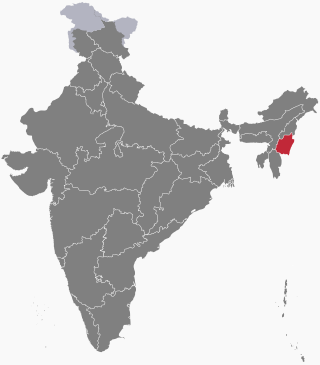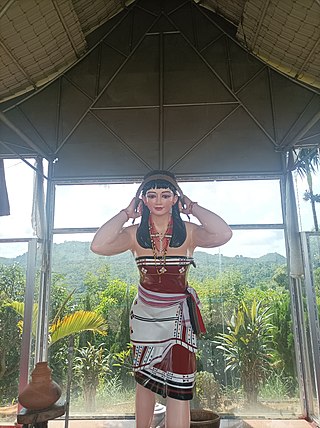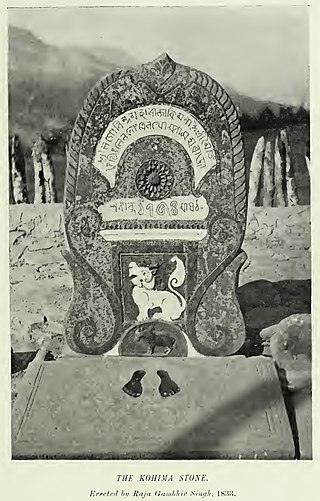
Manipur is a state in Northeast India, with the city of Imphal as its capital. It is bounded by the Indian states of Nagaland to the north, Mizoram to the south and Assam to the west. It also borders two regions of Myanmar, Sagaing Region to the east and Chin State to the south. The state covers an area of 22,327 square kilometres (8,621 sq mi). Manipur has been at the crossroads of Asian economic and cultural exchange for more than 2,500 years. It connects the Indian subcontinent and Central Asia to Southeast Asia, East Asia, Siberia, regions in the Arctic, Micronesia and Polynesia enabling migration of people, cultures and religions.

Meitei, also known as Manipuri, is a Tibeto-Burman language of northeast India. It is spoken by around 1.8 million people, predominantly in the state of Manipur, but also by smaller communities in the rest of the country and in parts of neighbouring Myanmar and Bangladesh. It is native to the Meitei people, and within Manipur it serves as an official language and a lingua franca. It was used as a court language in the historic Manipur Kingdom and is presently included among the 22 scheduled languages of India.

The Meitei people, also known as the Manipuri people, is the predominant ethnic group of Manipur in Northeast India. They speak Meitei language, one of the 22 official languages of the Indian Republic and the sole official language of Manipur. The Meiteis primarily settled in the Imphal Valley region in modern-day Manipur, though a sizable population has settled in the other Indian states of Assam, Tripura, Nagaland, Meghalaya, and Mizoram. There is also a notable presence of Meitei in the neighboring countries of Myanmar and Bangladesh. The Meitei ethnic group represents about 53% of Manipur's population.

Bishnupriya Manipuri, also known as Bishnupriya Meitei or simply as Bishnupriya, is an Indo-Aryan language belonging to the Bengali–Assamese linguistic sub-branch. It is a creole of Bengali language and Meitei language and it still retains its pre-Bengali features. It is spoken in parts of the Indian states of Assam, Tripura and Manipur as well as in the Sylhet Division of Bangladesh. It uses the Bengali-Assamese script as its writing system. Bishnupriya Manipuri, being a member of the Eastern Indo-Aryan languages, was evolved from Magadhi Prakrit. So, its origin is associated with Magadha realm. The Government of Tripura categorized Bishnnupriya Manipuri under the "Tribal Language Cell" of the State Council of Educational Research and Training. Its speakers are also given the "Other Backward Classes" status by the Assam Government and notably, there is no legal status of the Bishnupriyas in Manipur. In the 2020s, the Bishnupriya speaking people started demanding that the Assam Government should give them the status of “indigenous people” of Assam and treat the same like other indigenous communities of the state.

The Manipuri Dance, also referred to as the ManipuriRaas Leela, is one of the eight major Indian classical dance forms, originating from the state of Manipur. The dance form is imbued with the devotional themes of Madhura Raas of Radha-Krishna and characterised by gentle eyes and soft peaceful body movements. The facial expressions are peaceful mostly expressing Bhakti Rasa or the emotion of devotion, no matter if a dancer is Hindu or not. The dance form is based on Hindu scriptures of Vaishnavism and is exclusively attached to the worship of Radha and Krishna. It is a portrayal of the dance of divine love of Lord Krishna with goddess Radha and the cowherd damsels of Vrindavan, famously known as the Raas Leela.

The Meitei script, also known as the Meetei script, is an abugida used for the Meitei language, the official language of Manipur state and one of the 22 official languages of India. It is one of the official scripts of the Indian Republic. It is also popularly known as the Kanglei script and the Kok Sam Lai script. Its earliest known evidence of existence dates back to the 6th century AD coins, engraving the Meitei letters, as verified by the various publications of the National Sahitya Akademi. It was used until the 18th century, when it was replaced by the Bengali alphabet. A few manuscripts survive. In the 20th century, the script has experienced a resurgence, and is again being used. Starting from 2021, Meitei script was officially used by the Government of Manipur, along with the Bengali-Assamese script, to write the Meitei language, as per "The Manipur Official Language (Amendment) Act, 2021".

Singju is a dish from Manipur. It originated with the Meitei-culture but has been widely adopted by most of the ethnic communities of the state and in some neighbouring states of Northeast India. Often served as a spicy side dish, it is also a popular as an afternoon or evening snack.

Leimarel Sidabi or Leimalel Sitapi is a goddess in Meitei mythology and the religion of Ancient Kangleipak. She is the highest female divinity in the Meitei pantheon. She is the goddess of earth, of nature and the household. She is revered as the mother of every living being in the universe.

There are many different dance styles from Manipur, a state in northeastern India bordering with Myanmar (Burma), Assam, Nagaland and Mizoram. Manipuri dances encompasses both classical and folk dance forms. The Raas Leela is one of the major Indian classical dance forms. The folk dance forms are mainly attributed to ancient Meitei deities such as Umang Lai and performed during Lai Haraoba, and also the dances of the different tribal communities of Manipur.

Haoreima or Haoleima is a goddess of tragic love and separation in Meitei mythology and religion of Ancient Kangleipak. According to some legends, she was a woman from the hills, who was killed while arranging to meet her lover, and turned into a tortured spirit. She is regarded as an incarnation of Goddess Panthoibi. She is also identified with goddess Nongthang Leima. She is also worshipped as goddess Ireima. She is one of the most revered Meitei goddesses, though she is of Tangkhul origin.

The Kohima Stone Inscription or the Gambhir Singh's Stone is a Meitei language stone inscription, erected by Meitei King Raja Gambhir Singh of Manipur kingdom in Kohima, the capital of Nagaland. It was erected in 1833 AD as a mark of Manipuri conquest and supremacy over the Naga Hills in 1832 AD. It was inscribed in sanskritised Manipuri language in Bengali script. Manipuri King Raja Gambhir Singh conquered the whole Naga Hills with his military power of Manipur Levy. It was after he had finally defeated the Angami Nagas of Kohima that the historic testimonial stone inscription was erected.

Phouoibi (Fouoibi) or Phouoipi (Fouoipi) or Phouleima (Fouleima) or Phoureima (Foureima) is the goddess and the female personification of the agriculture, crops, fertility, grains, harvest, paddy, rice and wealth in Meitei mythology and religion of Ancient Kangleipak (early Manipur). She is the lover of Akongjamba, a hero in ancient legends. But fate doesn't permit the lovers to unite. So, Phouoibi and Akongjamba reincarnated in the legends. She was sent by Thangching (Thangjing) to Kege Moirang (Keke Moilang) kingdom to prosper the human world. The legends of her love with Akongjamba were believed to be enacted by Thangching (Thangjing) as a part of the Epic cycles of incarnations (Moirang Saiyon) of the Moirang Kangleirol legends.

Pureiromba is a God in Meitei mythology and religion. He is the giver of rain and agricultural prosperity. He is one of the major Umang Lai deities. He is the Ancestor God of the Angom clan of the Meitei ethnicity.

Meitei mythology or Manipuri mythology is a collection of myths, belonging to the religious and cultural traditions of the Meitei people, the predominant ethnic group of Manipur. It is associated with traditional Meitei religion (Sanamahism). Meitei myths are a part of Meitei culture and explain various natural phenomena, how the human civilization developed, and the reasons of many things happening. Most of the Meitei legends are found in the Meitei language texts.

Wangpulen is the god of water, rain, flood, disease and sickness in Meitei mythology and religion of Ancient Kangleipak . He is the ruler of the underwater world. He is the Lord of the rivers. The guardianship of the south eastern direction is alluded to Wangbren and the other directions to Koupalu, Marjing and Thangjing. He is one of the Umang Lais.

Phou Ningthou is a deity in Meitei mythology and religion (Sanamahism) of Ancient Kangleipak. He is the God and the divine male personification of the agriculture, crops, fertility, grains, harvesting, paddy, rice and wealth. He is the consort of Phouoibi (Phouleima), the goddess of crops and agricultural fertility.

Nongda Lairen Pakhangba, was the first Meitei monarch of the Ningthouja dynasty, who ascended the throne of the Kangla of Kangleipak in 33 AD, after the withdrawal of the mainstream powers of the Khabas. Before the reign of king Nongda Lairen Pakhangba, the clans, or salais were already in existence.

In Meitei mythology and folklore, the epic cycles of incarnations in Moirang is a cyclic epic of seven incarnations of two divine lovers in the kingdom of Moirang in the realm of Ancient Kangleipak.
Meidingu Naophangba was a Meetei ruler of Ningthouja dynasty of Ancient Manipur. He is the successor of Naokhamba and the predecessor of Sameiraang. He promulgated a proto-Constitution in 429 AD, which later grew into the Loyumba Shinyen, a written constitution in 1100 AD, during the reign of King Loyumba. He is one of the most outstanding figures in the history of Meitei architecture of Ancient Manipur. He laid the foundation stone of the Kangla, the "Namthak Sarongpung", which is the holiest place to the Manipuri ethnicity. During his reign, the coronation hall in the Kangla was inaugurated and a hog was sacrificed. According to the Loyumba Shinyen, he took command from Mangang Luwang Khuman for the administration of justice in the kingdom. According to the Chakparol, the ten villages of the Chakpas separated during his reign. It was right from his reign that the newcomers (immigrants) were assigned and admitted to the yek salai (clans) and the yumnaks (families) of the Meitei ethnicity. According to the Thengkourol, copper and brass were imported from Burma and China during his reign.
















